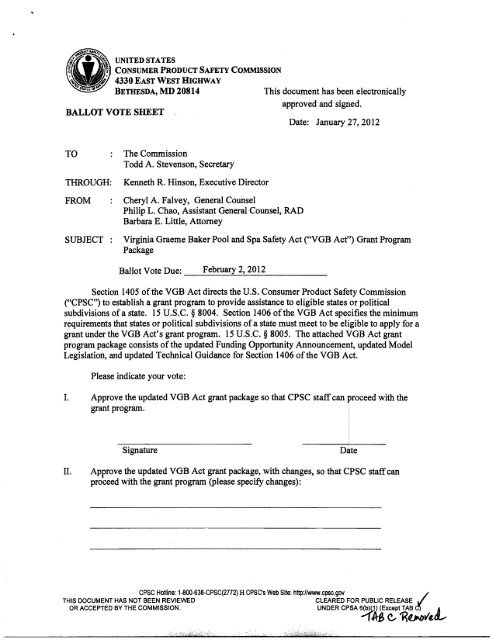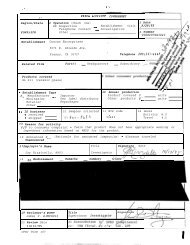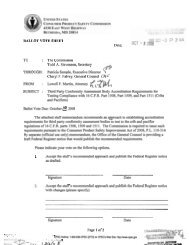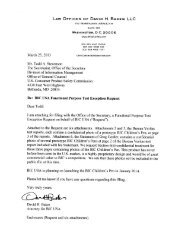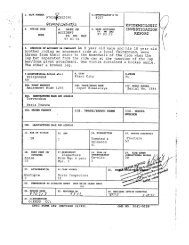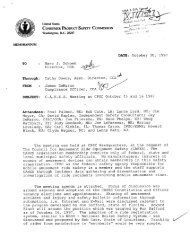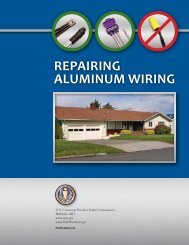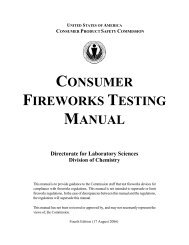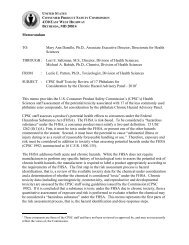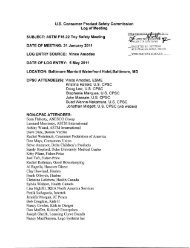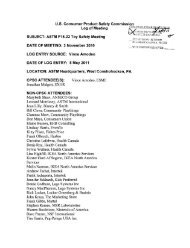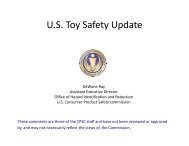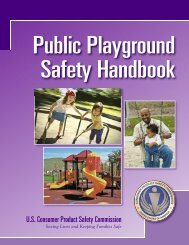Virginia Graeme Baker Pool and Spa Safety Act ("VGB Act") Grant ...
Virginia Graeme Baker Pool and Spa Safety Act ("VGB Act") Grant ...
Virginia Graeme Baker Pool and Spa Safety Act ("VGB Act") Grant ...
You also want an ePaper? Increase the reach of your titles
YUMPU automatically turns print PDFs into web optimized ePapers that Google loves.
ASME/ANSI A112.19.8. The updated documents are being provided with this briefing package<br />
for Commission review <strong>and</strong> decision.<br />
B. Background<br />
The <strong>VGB</strong> <strong>Act</strong> grant program is designed to provide financial assistance to eligible applicants<br />
for the purposes of:<br />
• hiring <strong>and</strong> training personnel to implement <strong>and</strong> enforce the awardee's swimming pool<br />
<strong>and</strong> spa safety law;<br />
• educating pool construction, installation, <strong>and</strong> service companies about the st<strong>and</strong>ard;<br />
• educating pool owners <strong>and</strong> operators <strong>and</strong> other members of the public about the st<strong>and</strong>ards<br />
under the applicant's swimming pool <strong>and</strong> spa safety law <strong>and</strong> about the prevention of<br />
drowning <strong>and</strong> entrapment of children in swimming pools <strong>and</strong> spas, <strong>and</strong><br />
• defraying the applicant's administrative costs associated with such training <strong>and</strong> education<br />
programs.<br />
At least 50 percent of the funds made available to a grant awardee are to be used for the<br />
hiring <strong>and</strong> training of enforcement personnel. There are no percentage restrictions attached to<br />
the use of the remaining funds to meet the other objectives.<br />
Section 1405(e) of the <strong>Act</strong> specified that, subject to funds availability, an amount of<br />
$2,000,000 was authorized to be appropriated for each of the fiscal years (FYs) 2009 <strong>and</strong> 2010.<br />
Those funds were appropriated, with spending obligations through September 30, 2010, for the<br />
2009 appropriated funds, <strong>and</strong> through September 30, 2011, for the FY 2010 appropriated funds.<br />
In 2010, CPSC began the process of establishing the grant program by entering into an<br />
interagency agreement ("IAA") with the National Center for Injury Prevention <strong>and</strong><br />
Control/Centers for Disease Control <strong>and</strong> Prevention ("NCIPCICDC") to administer the program<br />
(CPSC has no in-agency capability for administering such a program). With NCIPCICDC as the<br />
lead agency <strong>and</strong> CPSC staff providing input, an FOA was developed that provided information<br />
about eligibility to apply for a grant, application content <strong>and</strong> submission requirements,<br />
application review procedures, <strong>and</strong> application evaluation criteria. The FOA was published on<br />
March 29, 2010, on www.grants.gov, with a closing date for receipt of applications of May 28,<br />
2010. No states applied for a grant, <strong>and</strong> no grants were awarded in FY 2010.<br />
In the process of publishing the FOA, CPSC <strong>and</strong> NCIPC staffs learned that no state was<br />
eligible to apply for grants in FY 2010 <strong>and</strong> likely would not be in 2011. This was because states<br />
generally address pool safety-not through state law-but rather, through the enactment of local<br />
legislation or ordinances or adoption of national codes. When this was brought to the attention<br />
of the congressional sponsor of the legislation, the original spending obligation deadline of<br />
September 30, 2011, for the FY 2010 appropriated funds was extended to September 30, 2012.<br />
In addition, the following sentence was added to section 1405(e): "For purposes of eligibility for<br />
the grants authorized under section 1405, such term shall also include any political subdivision<br />
of a State." The change to the <strong>Act</strong> was not made before the deadline had passed for issuing an<br />
FOA, <strong>and</strong>,NCIPCICDC did not publish an FOA in FY 2011.<br />
-2
In the Model Legislation <strong>and</strong> Technical Guidance documents that the Conunission approved<br />
in 2010, CPSC staff interpreted the <strong>Act</strong> as requiring, for minimum eligibility purposes, a statute<br />
that would include barrier <strong>and</strong> entrapment prevention requirements for existing <strong>and</strong> newly built<br />
pools. In late summer 2011, CPSC <strong>and</strong> NCIPC/CDC sent an information e-mail message about<br />
the grant program to the e-maillistservs of approximately 5,000 members with an interest in pool<br />
safety. Information received in response to that message <strong>and</strong> from other general sources<br />
indicated concerns about meeting the eligibility requirements for existing pools. Thus, in the<br />
CPSC's FY 2012 appropriation, the language was changed to say that, for the minimum<br />
eligibility requirements of the grant program, the statute of the state or political subdivision of a<br />
state would apply to all swimming pools constructed after the date that is 6 months after the date<br />
of enactment of the Financial Services <strong>and</strong> General Government Appropriations <strong>Act</strong>, 2012 (i.e.,<br />
June 23, 2012)?<br />
Thus, two changes have been made to the <strong>VGB</strong> <strong>Act</strong>'s minimum eligibility requirements for<br />
applying for a grant under the grant program. These are: (1) the term "state" includes "any<br />
pOlitical subdivision of a state"; <strong>and</strong> (2) the minimum eligibility requirements are applicable only<br />
to pools constructed on or after June 23,2012.<br />
C. Implementation of the <strong>VGB</strong> <strong>Act</strong> <strong>Grant</strong> Program in FY 2012<br />
CPSC staff will continue its efforts to implement the <strong>VGB</strong> <strong>Act</strong> grant program in FY 2012.<br />
CPSC <strong>and</strong> NCIPC staffs have developed a draft FOA for publication in late March/early April<br />
2012. Applications will be due 60 days after publication, in late Mayor early June, <strong>and</strong> grants<br />
will be awarded in August 2012, with a project period duration of 1 year. To assist potential<br />
applicants with underst<strong>and</strong>ing <strong>and</strong> meeting the eligibility requirements for the grant program, the<br />
FOA will include by website link, CPSC staff's Model Legislation <strong>and</strong> Technical Guidance<br />
documents. These documents have been updated to incorporate the changes described above.<br />
The Model Legislation documents can be found at Tab A <strong>and</strong> the Technical Guidance for<br />
Section 1406 can be found at Tab B. Because the FOA has not been released to the public, it<br />
will be provided to the Commission under separate cover.<br />
The IAA that will be developed for the administration of the grant program by NCIPC/CDC<br />
will specify the tasks that each agency will complete to ensure implementation of the grant<br />
program <strong>and</strong> establish the cost to the CPSC of having NCIPCJCDC administer the program. To<br />
meet the direction of section 1405 of the <strong>Act</strong>-that the applicant must demonstrate to the<br />
satisfaction of the Commission that it has an existing statute, or amended an existing statute, <strong>and</strong><br />
provides for the enforcement of a law that meets the barrier <strong>and</strong> entrapment prevention<br />
requirements of the <strong>VGB</strong> <strong>Act</strong>-the FOA will require each applicant to have a Letter of Advice<br />
from the CPSC's Office of the General Counsel, stating that the applicant's statute meets the<br />
minimum eligibility requirements to apply for a grant.<br />
D. Options Available to the Commission<br />
1. Approve the Updated Model Legislation, Updated Technical Guidance, <strong>and</strong> Updated<br />
Funding Opportunity Announcement with No Changes<br />
3 There is one exception to this provision. Section 1406(a)(1 )(A) states that the state law must require that pools <strong>and</strong><br />
spas built more than J year after the date ofenacfment ofthe state's statute must have: (l) more than one drain; (2)<br />
1 or more unblockable drains; or (3) no main drain.<br />
-3
If the Commission agrees with the updates that have been incorporated into the three<br />
documents, it could approve the documents. This will enable staff to proceed with<br />
implementation of the <strong>VGB</strong> <strong>Act</strong> grant program in FY 2012.<br />
2. Approve the Updated Model Legislation, Updated Technical Guidance, <strong>and</strong> Updated<br />
Funding Opportunity Announcement with Changes<br />
If the Commission believes the updates to the documents should be changed, it could<br />
approve the documents, with changes. This would still enable staff to continue with<br />
implementation of the program in FY 2012, as long as the changes could be incorporated<br />
into the documents <strong>and</strong> staff could meet the timeline for publishing the FOA.<br />
3. Do Not Approve the Updated Model Legislation, Updated Technical Guidance, <strong>and</strong><br />
Updated Funding Opportunity Announcement<br />
If the Commission disagrees with the updates to the above documents, it could<br />
disapprove the documents, <strong>and</strong> staff would not be able to proceed with implementing the<br />
<strong>VGB</strong> grant program in FY 2012.<br />
E. Staff Recommendation<br />
Staff recommends that the Commission approve the updated Model Legislation, the updated<br />
Technical Guidance, <strong>and</strong> the updated Funding Opportunity Announcement. This will allow staff<br />
to implement the grant program that is statutorily required by the <strong>VGB</strong> act.<br />
Enclosures<br />
Tab A: Model Legislation (previously approved version with highlighted updates)<br />
Tab B: Updated Technical Guidance (previously approved version with highlighted updates)<br />
Under Separate Cover:<br />
Tab C: Updated Draft Funding Opportunity Announcement (For Official Use Only)<br />
-4
-5<br />
Tab A
(This Model Legislation is provided by the U.S. Consumer Product <strong>Safety</strong> Commission staff<br />
for the purpose of assisting state <strong>and</strong> local legislatures that desire to enact or amend<br />
existing legislation for the purpose of preventing child drowning <strong>and</strong> suction entrapment<br />
injuries <strong>and</strong> deaths in swimming pools <strong>and</strong> spas. This Model Legislation also is intended to<br />
assist states <strong>and</strong> political subdivisions that want to meet the minimum eligibility<br />
requirements for applying for a grant under Sections 1405 <strong>and</strong> 1406 of the <strong>Virginia</strong> <strong>Graeme</strong><br />
<strong>Baker</strong> <strong>Pool</strong> <strong>and</strong> <strong>Spa</strong> <strong>Safety</strong> <strong>Act</strong>.)<br />
MODEL UNIFORM STATE (OR POLITICAL SUBDIVISION) POOL AND<br />
SPA SAFETY BILL<br />
SECTION 1<br />
TITLE<br />
This <strong>Act</strong> shall be known <strong>and</strong> may be cited as the "[STATE or POLITI AL SUB DIVI ION ]<br />
<strong>Virginia</strong> <strong>Graeme</strong> <strong>Baker</strong> <strong>Pool</strong> <strong>and</strong> <strong>Spa</strong> <strong>Safety</strong> <strong>Act</strong>."<br />
SECTION 2<br />
PURPOSE<br />
This <strong>Act</strong> is intended to enhance the safety of public <strong>and</strong> residential pools <strong>and</strong> spas; encourage the<br />
use of layers of protection; reduce child drowning in pools <strong>and</strong> spas; reduce the number of<br />
suction entrapment incidents, injuries, <strong>and</strong> deaths; <strong>and</strong> educate the public on the importance of<br />
constant supervision of children in <strong>and</strong> around water.<br />
For the purposes of this <strong>Act</strong>:<br />
SECTION 3<br />
DEFINITIONS<br />
(a) ASMEIANSI.-The term "ASME/ANSI" as applied to a safety st<strong>and</strong>ard means a<br />
st<strong>and</strong>ard that is accredited by the American National St<strong>and</strong>ards Institute (ANSI) <strong>and</strong><br />
published by the American Society of Mechanical Engineers (ASME).<br />
(b) Automatic pump shut-off system.-An automatic pump shut-off system is a device that<br />
can sense a drain blockage <strong>and</strong> shut off the pump system. Some safety vacuum release<br />
systems may meet this definition.<br />
(c) Barrier.-The term "barrier" includes a natural or constructed topographical feature that<br />
prevents unpermitted access by young children to a swimming pool, <strong>and</strong>, with respect to<br />
a portable hot tub <strong>and</strong> a portable spa, a lockable cover.<br />
(d) Commission.-The term "Commission" means the U.S. Consumer Product <strong>Safety</strong><br />
Commission.<br />
(e) Drain disablement.-A device or system that disables the drain.<br />
(f) Gravity drainage system.- A gravity drainage system utilizing a collector tank is a<br />
swimming pool/spa with a separate water storage vessel from which the pool circulation<br />
pump draws water. Water moves from the pool to the collector tank due to atmospheric<br />
pressure, gravity <strong>and</strong> the displacement of water by bathers, which removes the need for<br />
direct suction at the pool. This type of system is also referred to as a reservoir, surge<br />
tank, or surge pit.<br />
-6
(g) Main drain.-The term "main drain" means a submerged suction outlet typically located<br />
at the bottom of a pool or spa to conduct water to a recirculating pump.<br />
(h) Multiple main drain system.-A multiple main drain system consists of, at a minimum,<br />
two fully submerged suction outlets per pump, with drain cover centers at least 3 feet<br />
apart.<br />
(i) Public pool or spa.-The term "public pool" or "public spa" means a pool or spa that isa.<br />
Open to the public generally, whether for a fee or free of charge;<br />
b. Open exclusively to-<br />
I. Members of an organization <strong>and</strong> their guests;<br />
11. Residents of a multi-unit apartment building, apartment complex,<br />
residential real estate development, or other multi-family residential area<br />
(other than a municipality, township, or other local government<br />
jurisdiction); or<br />
111. Patrons of a hotel or other public accommodations facility; or<br />
c. Operated by the Federal Government (or by a concessionaire on behalf of the<br />
Federal Government) for the benefit of members of the Armed Forces <strong>and</strong> their<br />
dependents or employees of any department or agency <strong>and</strong> their dependents, only<br />
to the extent these pools or spas are under the jurisdiction of the State.<br />
(j) <strong>Safety</strong> vacuum release system.-The term "safety vacuum release system" means a<br />
vacuum release system capable of providing vacuum release at a suction outlet where<br />
there is a high vacuum occurrence due to a suction outlet flow blockage. The safety<br />
vacuum release system ceases operation of the pump, reverses the circulation flow, or<br />
otherwise provides a vacuum release at a suction outlet when a blockage is detected. It<br />
has been tested by an independent third party <strong>and</strong> found to conform to ASMEIANSI<br />
st<strong>and</strong>ard A1l2.19.17 or ASTM st<strong>and</strong>ard F2387.<br />
(k) Single main drain.-A single main drain is a submerged suction outlet, with or without a<br />
skimmer, connected to a dedicated pool pump. Main drains do not drain the pool, spa, or<br />
hot tub, as a sink drain does in a sink, but rather connect to the pump to allow for<br />
circulation <strong>and</strong> filtration. A pool may have more than one single main drain if it has<br />
multiple suction outlets that are each connected to a dedicated pump. A group of suction<br />
outlets connected together is considered a single main drain if the centers of the outlets<br />
are located at a distance less than three 3 feet from each other.<br />
(1) Suction-limiting vent system.-A suction-limiting vent system is also called an<br />
atmospheric vent. It is a pipe teed to the suction side of the circulation system on one end<br />
<strong>and</strong> open to the atmosphere on the opposite end. The pipe is normally full of water equal<br />
to the same height as the pool. When a blockage occurs at the main drain, air is<br />
introduced into the suction line thus causing the pump to lose prime <strong>and</strong> relieving the<br />
suction forces at the main drain (suction outlet).<br />
(m)Swimming pool; spa.-The term "swimming pool" or "spa" means any outdoor or indoor<br />
stmcture intended for swimming or recreational bathing, including in-ground, on-ground,<br />
<strong>and</strong> above-ground structures, inflatable pools that can hold water over 24 inches deep, hot<br />
tubs, portable hot tubs, spas, portable spas, <strong>and</strong> non-portable wading pools.<br />
(n) Unblockable drain.-The term "unblockable drain" means a drain of any size <strong>and</strong> shape<br />
that a human body cannot sufficiently block to create a suction entrapment hazard.<br />
-7
I. Barriers.<br />
SECTION 4<br />
MINIMUM REQUIREMENTS<br />
All outdoor residential pools <strong>and</strong> spas constructed or installed after June 23, 2012, shall be<br />
enclosed by barriers to entry that will effectively prevent small children from gaining<br />
unsupervised <strong>and</strong> unfettered access to the pool or spa.<br />
Note: The State (or political subdivisioll) statute must require enclosure ofall outdoor<br />
residential pools <strong>and</strong> spas constructed or installed aiter June 23, 2072 by barrier to entry. Thus,<br />
this section applies to outdoor residential pools <strong>and</strong> spas (constru ted or in tailed after JUlie 23.<br />
2012); it does not apply to public pools <strong>and</strong> spas. The intent ofthese barriers is to effectively<br />
provide protection against drowning or near-drowning ofyoung children by preventing them<br />
from gaining unsupervised <strong>and</strong> unfettered access to swimming pools <strong>and</strong> spas.<br />
For purposes ofthe barrier requirement, a "swimming pool" or "spa" includes any outdoor<br />
structure intendedfor swimming or recreational bathing, including in-ground <strong>and</strong> above-ground<br />
structures. It includes portable hot tubs, spas, portable spas, <strong>and</strong> non-portable wading pools.<br />
CPSC staffhas interpreted "swimming pool" to include non-portable spas, non-portable hot<br />
tubs, <strong>and</strong> larger inflatable pools that can hold water over 24 inches deep ("larger inflatable<br />
pools"), regardless ofwhether the pool has a circulation system.<br />
Following is an explanation of what constitutes effective barriers to entry.<br />
Residential outdoor in-ground, on-ground, <strong>and</strong> above-ground swirruning pools <strong>and</strong> spas, larger<br />
inflatable pools that can hold water over 24 inches deep, portable spas <strong>and</strong> hot tubs (ex.cept as<br />
noted below), non-portable spas <strong>and</strong> hot tubs, <strong>and</strong> non portable wading pools, iROh:ldiRg eJtiStiRg<br />
pools BAd spas, shall meet the following requirements:<br />
>- Fences/<strong>and</strong> or Walls.<br />
-8
The top of a fence or wall used as a barrier shall be a minimum of 48 inches (1219 mm)<br />
above grade. The bottom of a fence sball be no more than 4 inches (102 mm) above grade when<br />
that grade is a hard surface such as cement/asphalt. The bottom of a fence shall be no more than<br />
2 inches (51 mm) above grade when that grade is a soft surface such as grass or ground/natural<br />
surface. All measurements shall be taken on the barrier side farthest from the pool.<br />
Solid barriers such as brick or rock walls shall have no indentations or protrusions that can<br />
provide h<strong>and</strong> <strong>and</strong>/or foot holds. NDrmal construction tolerances <strong>and</strong> masonry joints are allowed.<br />
Horizontal <strong>and</strong> vertical members: Where a fence is constructed of horizontal <strong>and</strong> vertical<br />
members, then:<br />
• If the distance between the top of the horizontal members is less than 45 inches<br />
(1143 mm), the horizontal members shall be located on the swimming pool side<br />
of the fence. The sp acing between the vertical members shall not exceed 1-3/4<br />
inches (44 mm) in width. Any decorative cutout spacing within vertical members<br />
of the fence shallll()t exceed 1-3/4 inches (44 mm) in width.<br />
• If the distance betwt:en the tops of the horizontal members is 45 inches (1143<br />
mm) or more, the spadng between the vertical members shall not exceed 4 inches<br />
(102 mm) in width. Any decorative cutout spacing within vertical members of the<br />
fence shall not exceed 1-3/4 inches (44 mm) in width.<br />
Diagonal members: For a fence made up of crossed wood, polyvinyl chloride (PVC), or<br />
metal strips (latticework), the maximum opening between the diagonal members shall not exceed<br />
1-3/4 inches (44 mm).<br />
Chain link fence: The maximllm mesh size for a chain link fence shall not exceed 1-1/4<br />
inches (32 mm) square [1 -3/4 inch.es (44 mm) diagonal]. A larger mesh size may be used if slats<br />
fastened at the top or bottom of tbe fence are used to reduce mesh openings to no more than 1<br />
3/4 inches (44 mm). See Figure A .<br />
-9
Figure A. Maximum chain link fence opening.<br />
Mesh fencing: Removable mesh fencing for swinuning pools shall meet the requirements of<br />
AS1M F2286-05: "Design <strong>and</strong> Performance Specification for Removable Mesh for Swimming<br />
<strong>Pool</strong>s, Hot Tubs, <strong>and</strong> <strong>Spa</strong>s".<br />
<strong>Pool</strong> structure as barrier: For above-ground or on-ground pools, the pool structure itself may<br />
serve as a ground level barrier only if it is at least 48 inches (1219 mm) high. If the top of the<br />
pool structure is less than 48 inches (1219 mm) above grade <strong>and</strong> a barrier is mounted on top of<br />
the pool structure, the maximum vertical clearance between the top of the pool structure <strong>and</strong> the<br />
bottom of the barrier shall be 4 inches (102 mm).<br />
then:<br />
Ladder or steps: Where access to an above-ground pool is provided by a ladder or steps,<br />
• The steps or ladder shall be designed to be secured, locked, or removed to prevent<br />
access, or<br />
• A barrier such as one described under "Fences <strong>and</strong>/or Walls," above, shall<br />
surround the steps or ladder.<br />
-10
Residential outdoor portable spas <strong>and</strong> residential outdoor portable hot tubs. Residential outdoor<br />
portable spas <strong>and</strong> residential outdoor portable hot tubs are exempt from the "Fences <strong>and</strong>/or<br />
Walls" requirements, if <strong>and</strong> only if, they have a lockable manual safety cover that complies with<br />
ASTM F1346.<br />
All Baniers. All barriers shall be located so as to prohibit permanent structures, equipment, or<br />
similar objects from being used to climb the barriers.<br />
Additional Layers of Protection-Baniers. Additional layers of protection are available. These<br />
are not required for meeting the minimum eligibility requirements for purposes of the <strong>VGB</strong> <strong>Pool</strong><br />
<strong>and</strong> <strong>Spa</strong> <strong>Safety</strong> <strong>Grant</strong> Program, but CPSC encourages their use. See Section III below.<br />
II. Entrapment.<br />
A. All pools <strong>and</strong> spas constructed or installed after June 23, 2012, shaH be equipped<br />
with devices <strong>and</strong> systems designed to prevent entrapment by pool or spa drains.<br />
This means that for purpo e of the grant program, all pools <strong>and</strong> spas con tru led or insta lled<br />
after June 2 .2012 both residential <strong>and</strong> public, must be equipped with devices <strong>and</strong> systems<br />
designed to prevent entrapment by pool or spa drains. Devices <strong>and</strong> systems designed to<br />
prevent entrapment by pool or spa drains may include multiple drain systems (including<br />
pools without a single main drain), a safety vacuum release system, a suction-limiting vent<br />
system, a gravity drainage system, an automatic pump shut-off system, an I:Inblockah le drain<br />
€&¥ef; or drain disablement. The presence of anyone of these devices or systems satisfies this<br />
requirement. Portable spas certified to UL 1563 by a Nationally Recognized Testing<br />
Laboratory (NRTL) are considered to comply with the entrapment prevention provisions of<br />
the <strong>Act</strong>.<br />
B. <strong>Pool</strong>s <strong>and</strong> spas built more than one year after the date of the eRaetfBent of this title<br />
constructed or installed after June 23, 2012 shall have-<br />
a. More than one drain;<br />
-12
No single main drain. A single main drain is a submerged suction outlet, with or without a<br />
skimmer, connected to a dedicated pool pump. It is possible for a pool to be constructed with<br />
more than one single main drain. A pool with more than one single main drain would also<br />
violate the requirement for no single main drain.<br />
c. Every swimming pool <strong>and</strong> spa constructed or installed after June 23, 201 2 that has a<br />
main drain, other than an unblockable drain, shall be equipped with a drain cover<br />
that meets the consumer product safety st<strong>and</strong>ard established by section 1404 of the<br />
<strong>Virginia</strong> <strong>Graeme</strong> <strong>Baker</strong> <strong>Pool</strong> <strong>and</strong> <strong>Spa</strong> <strong>Safety</strong> <strong>Act</strong>.<br />
This applies to residential swimming pools <strong>and</strong> pas con tructed after June 23, 20 12 that do not<br />
have unblockable drains. Residential <strong>and</strong> public swimming pools with drains that are blockable<br />
must be equipped with a drain cover that meets A8MElAl\[8 1 A 11 2. 19.8 ANS IJAPS P- 16-20J l.<br />
(AN IJAPS P - 16 -20 I I is the successor ' t<strong>and</strong>ard to ASMElANSJ Al 12-19.8. The st<strong>and</strong> ard<br />
are virtu ally identical.)<br />
D. Periodic notification shall be provided to owners of residential swimming pools or<br />
spas about compliance with the entrapment protection st<strong>and</strong>ards of the<br />
ASMElANSl A112.19.8 ANSIIAPSP-16-20n performance st<strong>and</strong>ard. or any<br />
sueeessor st<strong>and</strong>ard.<br />
The State ( r politica l subdi vision) shall ensure that periodic notification is provided to owners<br />
of residential swimming pools or spas about the compliance with the entrapment protection<br />
st<strong>and</strong>ards of ASM.E/AN8f AI 12.19.8 AN IIAPSP -16-20 I L performance t<strong>and</strong>ard. eHlflj'<br />
SI:I Gcessor staAdard.<br />
E. No liabiJity inference associated with state (or political subdivision) notification<br />
requirement.-The minimum State (or political subdivision) law notification<br />
-14
equirement under paragraph (D) shall not be construed to imply any liability on<br />
the part of a State (or political subdivision) related to that requirement.<br />
The notification requirement does not impart any liabiHty to the State (or political ubdi vi ion)<br />
in the event of an entrapment inddent.<br />
-15
Please note that what follows on the next page represents requirements that a State (or political<br />
subdivision) may wish to consider. A State (or political sllbdivision) statute need not require<br />
these basic access-related safety devices <strong>and</strong> equipment in order to be eligible for a grant.<br />
-16
III. "Basic Access-Related <strong>Safety</strong> Devices <strong>and</strong> Equipment"<br />
A. Window Guards.<br />
A window in a wall that allows access to the pool may be equipped with window guards that<br />
limit access or be affixed with a childproof device to limit the window opening to less than 4<br />
inches. The window guard shall meet ASTM F2006 <strong>Safety</strong> Specification for Window Fall<br />
Prevention Devices for Non-Emergency Escape (Egress) <strong>and</strong> Rescue (Ingress) Windows.<br />
B. Swimming <strong>Pool</strong> Alarms.<br />
A pool alarm may be used to provide warning that a pool has been entered. A pool-based<br />
alarm may be either a surface or subsurface alarm. Surface alarms float on a pool's surface <strong>and</strong><br />
are activated by waves in the pool. Subsurface alarms respond to pressure waves under the water<br />
surface, generated by the displacement of water when an object enters the pool. Perimeter<br />
alarms, if used, should be used in conjunction with barriers meeting the barrier requirements of<br />
section (a). All alarms shall meet the requirements of ASTM F2208 St<strong>and</strong>ard Specification for<br />
<strong>Pool</strong> Alarms.<br />
-17
-18<br />
TabB
equirements, <strong>and</strong> CPSC staff notes that States <strong>and</strong> political subdivisions of a State are free <strong>and</strong><br />
encouraged to go above <strong>and</strong> beyond these minimum requirements, so long as the additional<br />
requirements do not conflict with the <strong>Act</strong>.<br />
1. Barriers 8<br />
The <strong>Act</strong> defines "swimming pool" or "spa" as "any outdoor or indoor structure intended for<br />
swimming or recreational bathing, including in-ground <strong>and</strong> above-ground structures, <strong>and</strong><br />
includes portable hot tubs, spas, portable spas, <strong>and</strong> non-portable wading pools". P.L. No.110<br />
140, § 1403. The CPSC staff interprets this definition to also include on-ground pools <strong>and</strong> spas,<br />
non-portable spas, non-portable hot tubs, <strong>and</strong> larger inflatable pools that can hold water over 24<br />
inches deep, regardless of whether the pool has a circulation system.<br />
To be eligible for a grant, the State or political ubdivision of a Slate must have in place a<br />
statute that requires the enclosure of all outdoor residential pools <strong>and</strong> spas conslrucled or<br />
installed after June 23, 2012, by barrier to entry. Pub. L. No. 110-140, §1406(a)(1)(A)(i). The<br />
CPSC steff imerpFets !H.is 18 iHe/Mde &is,irl:g peels €mB 5fJ61s. Further, according to the <strong>Act</strong>, the<br />
barriers to entry should effectively provide protection against potential drowning or neardrowning<br />
of young children by preventing them from gaining unsupervised <strong>and</strong> unfettered access<br />
to outdoor residential swimming pools <strong>and</strong> spas.<br />
The CPSC staff's judgment <strong>and</strong> interpretation as to what an effective minimum barrier should<br />
entail, for the purposes of applying for a grant under the <strong>Act</strong>, follows. As already noted, these<br />
requirements are minimum requirements, <strong>and</strong> CPSC staff notes that States <strong>and</strong> po li tical<br />
subdivision' of a Scare are free <strong>and</strong> encouraged to go above <strong>and</strong> beyond these minimum<br />
requirements, so long as the additional requirements do not conflict with the <strong>Act</strong>.<br />
Residential outdoor in-ground, on-ground, <strong>and</strong> above-ground swimming pools <strong>and</strong> spas,<br />
larger inflatable pools that can hold water over 24 inches deep, non-portable spas <strong>and</strong> hot<br />
tubs, portable spas <strong>and</strong> hot tubs (except as noted in Sec. 1.4 below), <strong>and</strong> non-portable<br />
wading pools, including existing pools <strong>and</strong> spas, constructed or installed after June 23,<br />
2012, shall have a barrier which complies with the following requirements:<br />
1.1 Fences <strong>and</strong>/or Walls<br />
1.1.1 The top of a fence or wall used as a barrier shall be a minimum of 48 inches<br />
(1219 mm) above grade. The bottom of a fence shall be no more than 4 inches<br />
(102 mm) above grade when that grade is a hard surface, such as<br />
cement/asphalt. The bottom of a fence shall be no more than 2 inches (51 mm)<br />
above grade when that grade is a soft surface, such as grass or ground/natural<br />
surface. All measurements shall be taken on the barrier side farthest from the<br />
pool.<br />
8 This section is based on CPsc <strong>Safety</strong> Barrier Guidelines for Home <strong>Pool</strong>s, CPSC Publication No. 362, U.S.<br />
Consumer Product <strong>Safety</strong> Commission, Washington, D.C.<br />
-20
1.1.1.1 Solid barriers such as brick or rock walls, shall have no indentations or<br />
protrusions that can provide h<strong>and</strong> <strong>and</strong>/or foot holds. Normal<br />
construction tolerances <strong>and</strong> masonry joints are allowed.<br />
1.1.2 Where a barrier (fence) is constructed of horizontal <strong>and</strong> vertical members,<br />
then:<br />
1.1.2.1 If the distance between the tops of the horizontal members is less than<br />
45 inches (1143 mm), the horizontal members shall be located on the<br />
swimming pool side of the fence. The spacing between the vertical<br />
members shall not exceed 1 % inches (44 mm) in width.<br />
1.1.2.2 If the distance between the tops of the horizontal members is 45 inches<br />
(1143 mm) or more, the spacing between the vertical members of the<br />
fence shall not exceed 4 inches (102 mm) in width.<br />
1.1.2.3 Any decorative cutout spacing within vertical members of the fence<br />
shall not exceed 1 % inches (44 mm) in width.<br />
1.1.3 The maximum mesh size for a chain link fence shall not exceed 11,4 inches (32<br />
mm) square [1 % inches (44 mm) diagonal.] A larger mesh size may be used if<br />
slats fastened at the top or bottom of the fence are used to reduce mesh<br />
openings to no more than 1 % inches (44 mm). See Figure A on the next page.<br />
Figure A. Maximum chain link fence opening.<br />
1.1.4 For a barrier (fence) made up of crossed wood, polyvinyl chloride (PVC), or<br />
metal strips (latticework), the maximum opening between the diagonal<br />
members shall not exceed 1 % inches (44 mm).<br />
1.1.5 Removable mesh fencing for swimming pools should meet the requirements of<br />
ASTM F2286-05: "Design <strong>and</strong> Performance Specification for Removable<br />
Mesh Fencing for Swimming <strong>Pool</strong>s, Hot Tubs, <strong>and</strong> <strong>Spa</strong>s."<br />
-21
1.1.6 For above-ground or on-ground pools, the pool structure itself may serve as a<br />
ground level barrier only if it is at least 48 inches (1219 mm) high. If the top of<br />
the pool structure is less than 48 inches above grade <strong>and</strong> a barrier is mounted<br />
on top of the pool structure to make it at least 48 inches (1219 mm) high, then<br />
the maximum vertical clearance between the top of the pool structure <strong>and</strong> the<br />
bottom of the barrier shall be 4 inches (102 mm). See also Section 1.5 below.<br />
1.2 Access Gates<br />
1.1.6.1 Where access to an above-ground pool is provided by a ladder or steps,<br />
then:<br />
1.1.6.1.1 The steps or ladder shall be designed to be secured, locked,<br />
or removed to prevent access, or<br />
1.1.6.1.2 A barrier such as one described in Section 1.1.1 above shall<br />
surround the steps or ladder.<br />
1.2.1 Access gates shall meet the requirements of Section 1.1 (Fences <strong>and</strong>/or Walls)<br />
above <strong>and</strong> shall be equipped to accommodate a locking device.<br />
1.2.2 Pedestrian access gates shall open outward away from the pool <strong>and</strong> shall be<br />
self-closing <strong>and</strong> self-latching. A locking device shall be included in the gate<br />
design. Where the release mechanism of the self-latching device is less than<br />
54 inches (1372 mm) from the bottom of the gate, the release mechanism <strong>and</strong><br />
openings must comply with the following:<br />
1.2.2.1 The release mechanism shall be on the pool side of the gate at least 3<br />
inches (76 mm) below the top of the gate, <strong>and</strong><br />
1.2.2.2 The gate <strong>and</strong> barrier shall have no opening greater than Y2 inch (13 mm)<br />
within 18 inches (457 mm) of the release mechanism.<br />
1.2.3 Access gates used with removable mesh fencing systems must meet the<br />
requirements of Section 1.2.1, i.e., manual "layback" entrances do not meet the<br />
requirement.<br />
1.2.4 Gates other than those for pedestrian access shall be equipped with a selflatching<br />
device.<br />
1.3 Dwelling Walls<br />
1.3.1 For swimming pools or spas where dwelling walls serve as a part of a<br />
barrier, one of the following shall be in place:<br />
-22
1.3.1.1 A door in the wall that provides direct access to the pool<br />
shall be equipped with an audible alarm system meeting<br />
Underwriters Laboratories Inc. (UL) st<strong>and</strong>ard UL 2017<br />
General-Purpose Signaling Devices <strong>and</strong> Systems, Section 77,<br />
Residential Water Hazard Entrance Alann Equipment.<br />
1.3.1.1.1 The alarm system shall be equipped with a manual<br />
means to temporarily deactivate the alann for not more<br />
than 15 seconds.<br />
1.3.1.1.2 The deactivation means shall be located not less<br />
than 54 inches (1372 mm) from the floor or threshold of<br />
the door.<br />
1.3.1.2 A power safety cover for swimming pools or a manual lockable safety<br />
cover for non-portable spas <strong>and</strong> non-portable hot tubs that meets the<br />
requirements of ASTM F1346 Performance Specification for <strong>Safety</strong><br />
Covers <strong>and</strong> Labeling Requirements for All Covers for Swimming<br />
<strong>Pool</strong>s, <strong>Spa</strong>s, <strong>and</strong> Hot Tubs.<br />
1.4 Residential outdoor portable spas <strong>and</strong> residential outdoor portable hot tubs are<br />
exempt from the requirements listed in Sections 1.1 (Fences <strong>and</strong>/or Walls), 1.2<br />
(Access Gates), <strong>and</strong> 1.3 (DwelUng Walls) above. However, if fences <strong>and</strong>/or walls<br />
meeting the requirements of Sections 1.1 - 1.3 are not used as a barrier to entry, then<br />
a lockable manual safety cover that complies with ASTM F1346 must be used.<br />
I.S All barriers should be located so as to prohibit permanent stmctures, equipment, or<br />
similar objects from being used to climb the barriers.<br />
1.6. Additional Layers of Protection that provide a barrier to entry are available. These<br />
are not required for meeting the minimum eligibility requirements for purposes of the<br />
<strong>Act</strong>'s <strong>Grant</strong> Program, but CPSC encourages their use. See Section 3 below.<br />
2. Entrapment Prevention Devices<br />
Section 1406 of the <strong>Act</strong> also sets forth that States or political subdivi ion of a Stale, in order<br />
to be eligible for a grant, must have in their statutes certain minimum requirements to prevent<br />
entrapment. These requirements apply to all pools <strong>and</strong> spas, public <strong>and</strong> residential, including inground<br />
<strong>and</strong> above-ground pools, portable <strong>and</strong> non-portable hot tubs, portable <strong>and</strong> non-portable<br />
spas, <strong>and</strong> non-portable wading pools constfllcted or installed after June 23 201 2. Pub. L.<br />
No.110-140, §1403.<br />
These entrapment prevention requirements are minimum requirements the States or political<br />
subdivisions f a Slate must include in their statutes to be eligible for a grant under the <strong>Act</strong>, <strong>and</strong><br />
-23
201 1 i the suee sor . t<strong>and</strong>ard to ASME/ANSI A I1 2. 19.8. Th (<strong>and</strong>nrds are<br />
virruall y identica l.<br />
3. Additional Layers of Protection<br />
Although not required for purposes of meeting nulllmum eligibility requirements for<br />
applying for grants under the <strong>Act</strong>'s grant program, States or political subdivisions of a tate are<br />
encouraged to consider requirements for additional layers of protection to supplement the<br />
requirements described in Section 1 (Barriers) <strong>and</strong> Section 2 (Entrapment Prevention Devices)<br />
above. The following devices have been identified by CPSC staff as additional safety<br />
requirements that States or p liti a1 ubdivi -ions of a State are encouraged to include in their<br />
statutes.<br />
3.1 Window Guards<br />
3.1.1 A window in a wall that allows access to the pool or spa may be equipped with<br />
window guards that limit access or be affixed with a childproof device to limit<br />
the window opening to less than 4 inches (102 mm). The window guard shall<br />
meet ASTM F2006 <strong>Safety</strong> Specification for Window Fall Prevention Devices<br />
for Non-Emergency Escape (Egress) <strong>and</strong> Rescue (Ingress) Windows.<br />
3.2 Swimming <strong>Pool</strong> Alarms<br />
3.2.1 A pool alarm may be used to provide warning that a pool has been entered.<br />
Surface <strong>and</strong> sub-surface pool-based alarms are available, as well as perimeter<br />
alarms that monitor the pool area. All alarms shall meet the requirements of<br />
ASTM F2208 St<strong>and</strong>ard Specification for <strong>Pool</strong> Alarms.<br />
3.2.1.1 Surface alarms float on the pool's surface <strong>and</strong> are activated by waves in<br />
the pool. The device shall provide an alarm at the pool <strong>and</strong> within the<br />
residence <strong>and</strong> shall meet the requirements of ASTM F2208.<br />
3.2.1.2 Subsurface alarms respond to pressure waves under the water surface,<br />
generated by the displacement of water when an object enters the pool.<br />
The device shall provide an alarm at the pool <strong>and</strong> within the residence<br />
<strong>and</strong> shall meet the requirements of ASTIvI F2208.<br />
3.2.2 Perimeter alarms, used in conjunction with barriers meeting the requirements<br />
of Sections 1.1 - 1.3 above shall meet the performance requirements of<br />
ASTM F2208.<br />
4. National Consensus St<strong>and</strong>ards <strong>and</strong> Guides<br />
Barriers<br />
-25
- Fencing<br />
• ASTM F1908 - 08 St<strong>and</strong>ard Guide for Fences for Residential Outdoor<br />
Swimming <strong>Pool</strong>s, Hot Tubs, <strong>and</strong> <strong>Spa</strong>s<br />
www.atm.org/St<strong>and</strong>ards/F1908.htm<br />
• ASTM F2286 - 05 St<strong>and</strong>ard Design <strong>and</strong> Performance Specifications for<br />
Removable Mesh Fencingfor Swimming <strong>Pool</strong>s, Hot Tubs, <strong>and</strong> <strong>Spa</strong>s<br />
www.alm.org/St<strong>and</strong>ardsIF2286.htm<br />
- <strong>Pool</strong>, <strong>Spa</strong>, <strong>and</strong> Hot Tub Covers<br />
• ASTM F1346 - 91(2003) St<strong>and</strong>ard Performance Specification for <strong>Safety</strong><br />
Covers <strong>and</strong> Labeling Requirements for All Covers for Swimming <strong>Pool</strong>s, <strong>Spa</strong>s<br />
<strong>and</strong> Hot Tubs<br />
www.astm.org/St<strong>and</strong>ards/FI346.htm<br />
- Windows<br />
• ASTM F2006 <strong>Safety</strong> Specification for Window Fall Prevention Devicesfor<br />
Non-Emergency Escape (Egress) <strong>and</strong> Rescue (Ingress) Windows<br />
www.astm.orgiSt<strong>and</strong>ardsIF2006.hLm<br />
- Entrance Alarms<br />
• UL 2017 General - Purpose Signaling Devices <strong>and</strong> Systems, Section 77,<br />
Residential Water Hazard Entrance Alarm Equipment<br />
www.comm-2000.com<br />
- Residential <strong>Pool</strong> Alarms<br />
• ASTM F2208 - 08 St<strong>and</strong>ard <strong>Safety</strong> Specification for Residential <strong>Pool</strong> Alarms<br />
www.aslm.org/St<strong>and</strong>ards/F2208.htm<br />
- General<br />
• ASTM F2518 - 06 St<strong>and</strong>ard Guide for Use ofa Residential Swimming <strong>Pool</strong>,<br />
<strong>Spa</strong>, <strong>and</strong> Hot Tub <strong>Safety</strong> Audit to Prevent Unintentional Drowning<br />
www.a5tm.org/St<strong>and</strong>ard/F2518.htm<br />
Entrapment Prevention<br />
- Suction Fittings<br />
• ASME/ANSI A112.19.8 - 2007 (addendum 8a-2008) Suction Fittings for<br />
Use in Swimming <strong>Pool</strong>s, Wading pools, <strong>Spa</strong>s, <strong>and</strong> Hot Tubs<br />
www.asme.org (Enter Al12.19.8 into "Search ASME" field)<br />
or<br />
-26
http://webstore.ansi.org (Enter A112.19.B into "Enter Document Number"<br />
field)<br />
ANSIIAPSP -16-2011 St<strong>and</strong>ard Suction Fittings for Use in Swimming <strong>Pool</strong>s,<br />
wading pools, <strong>Spa</strong>s, <strong>and</strong> Hot Tubs<br />
www.apsp.orgfulility/showProduct/index.cfm?objecllD=259J<br />
- <strong>Safety</strong> Vacuum Release Systems<br />
• ASTM F2387 - 04 St<strong>and</strong>ard Specification for Manufactured <strong>Safety</strong> Vacuum<br />
Release Systems (SVRS) for Swimming <strong>Pool</strong>s, <strong>Spa</strong>s, <strong>and</strong> Hot Tubs<br />
www.astm.org/Sl<strong>and</strong>ards/F287.html<br />
• ASl\1E/ANSI A112.19.17 - 2002 Manufactured <strong>Safety</strong> Vacuum Release<br />
Systems (SVRS) for Residential <strong>and</strong> Commercial Swimming <strong>Pool</strong>, <strong>Spa</strong>s, Hot<br />
Tub <strong>and</strong> Wading <strong>Pool</strong> Suction Systems<br />
wWW.tl me.Off! (Enter Al12.19.17 into "Search ASME" field)<br />
or<br />
http://webstorc.ansi.ofe (Enter A 112.19.17 into "Enter Document Number"<br />
field)<br />
5. General Note about the <strong>Virginia</strong> <strong>Graeme</strong> <strong>Baker</strong> <strong>Pool</strong> <strong>and</strong><br />
<strong>Spa</strong> <strong>Safety</strong> <strong>Act</strong><br />
Section 1405(d) of the <strong>Act</strong>, as amended, requires that any State or poli ti al ubdivision of<br />
a State receiving grant funds shall use at least 50 percent of the grant amount to hire <strong>and</strong> train<br />
enforcement personnel for implementation <strong>and</strong> enforcement of the State's or political<br />
subdivision of a State's swimming pool <strong>and</strong> spa safety law. The remaining money shall be used<br />
to educate pool construction, installation, <strong>and</strong> service companies about the st<strong>and</strong>ards <strong>and</strong> to<br />
educate pool owners, operators, <strong>and</strong> the public about pool safety <strong>and</strong> drowning <strong>and</strong> entrapment<br />
prevention, as well as to defray any administrative costs associated with training <strong>and</strong> education<br />
programs. A copy of the <strong>Act</strong> can be accessed at www.puulsafel 't' .gov/ps!ia.-!*i-h<br />
www.poolsafely.!!.ov/pool-spa-safery-acl.reaJ/.<br />
-27


